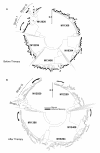Varied sensitivity to therapy of HIV-1 strains in CD4+ lymphocyte sub-populations upon ART initiation
- PMID: 21134247
- PMCID: PMC3004805
- DOI: 10.1186/1742-6405-7-42
Varied sensitivity to therapy of HIV-1 strains in CD4+ lymphocyte sub-populations upon ART initiation
Abstract
Background: Although antiretroviral therapy (ART) has proven its success against HIV-1, the long lifespan of infected cells and viral latency prevent eradication. In this study we analyzed the sensitivity to ART of HIV-1 strains in naïve, central memory and effector memory CD4+ lymphocyte subsets.
Methods: From five patients cellular HIV-1 infection levels were quantified before and after initiation of therapy (2-5 weeks). Through sequencing the C2V3 region of the HIV-1 gp120 envelope, we studied the effect of short-term therapy on virus variants derived from naïve, central memory and effector memory CD4+ lymphocyte subsets.
Results: During short-term ART, HIV-1 infection levels declined in all lymphocyte subsets but not as much as RNA levels in serum. Virus diversity in the naïve and central memory lymphocyte populations remained unchanged, whilst diversity decreased in serum and the effector memory lymphocytes. ART differentially affected the virus populations co-circulating in one individual harboring a dual HIV-1 infection. Changes in V3 charge were found in all individuals after ART initiation with increases within the effector memory subset and decreases found in the naïve cell population.
Conclusions: During early ART virus diversity is affected mainly in the serum and effector memory cell compartments. Differential alterations in V3 charge were observed between effector memory and naïve populations. While certain cell populations can be targeted preferentially during early ART, some virus strains demonstrate varied sensitivity to therapy, as shown from studying two strains within a dual HIV-1 infected individual.
Figures





Similar articles
-
CXCR4-Using HIV Strains Predominate in Naive and Central Memory CD4+ T Cells in People Living with HIV on Antiretroviral Therapy: Implications for How Latency Is Established and Maintained.J Virol. 2020 Feb 28;94(6):e01736-19. doi: 10.1128/JVI.01736-19. Print 2020 Feb 28. J Virol. 2020. PMID: 31852784 Free PMC article.
-
Genetic Diversity, Compartmentalization, and Age of HIV Proviruses Persisting in CD4+ T Cell Subsets during Long-Term Combination Antiretroviral Therapy.J Virol. 2020 Feb 14;94(5):e01786-19. doi: 10.1128/JVI.01786-19. Print 2020 Feb 14. J Virol. 2020. PMID: 31776273 Free PMC article.
-
Differentiation into an Effector Memory Phenotype Potentiates HIV-1 Latency Reversal in CD4+ T Cells.J Virol. 2019 Nov 26;93(24):e00969-19. doi: 10.1128/JVI.00969-19. Print 2019 Dec 15. J Virol. 2019. PMID: 31578289 Free PMC article.
-
Episomal HIV-1 DNA and its relationship to other markers of HIV-1 persistence.Retrovirology. 2018 Jan 30;15(1):15. doi: 10.1186/s12977-018-0398-1. Retrovirology. 2018. PMID: 29378611 Free PMC article. Review.
-
[Deep lung--cellular reaction to HIV].Rev Port Pneumol. 2007 Mar-Apr;13(2):175-212. Rev Port Pneumol. 2007. PMID: 17492233 Review. Portuguese.
Cited by
-
Lack of concordance between residual viremia and viral variants driving de novo infection of CD4(+) T cells on ART.Retrovirology. 2016 Aug 2;13(1):51. doi: 10.1186/s12977-016-0282-9. Retrovirology. 2016. PMID: 27484989 Free PMC article.
-
Analysis of multiple cell reservoirs expressing unspliced HIV-1 gag-pol mRNA in patients on antiretroviral therapy.Future Virol. 2012 Aug;7(8):819-832. doi: 10.2217/fvl.12.69. Future Virol. 2012. PMID: 23125871 Free PMC article.
-
High CCR5 density on central memory CD4+ T cells in acute HIV-1 infection is mostly associated with rapid disease progression.PLoS One. 2012;7(11):e49526. doi: 10.1371/journal.pone.0049526. Epub 2012 Nov 21. PLoS One. 2012. PMID: 23185351 Free PMC article.
References
-
- Mallon PW. Pathogenesis of lipodystrophy and lipid abnormalities in patients taking antiretroviral therapy. AIDS Rev. 2007;9:3–15. - PubMed
-
- Volmink J, Siegfried NL, Van der Merwe L, Brocklehurst P. Antiretrovirals for reducing the risk of mother-to-child transmission of HIV infection. Cochrane Database Syst Rev. 2007. p. CD003510. - PubMed
LinkOut - more resources
Full Text Sources
Research Materials

